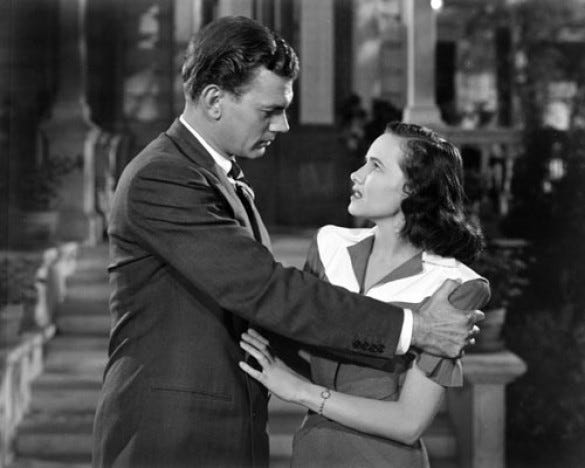Same-name-ism
Charlie, Charlie. Thomas, Thomas. Barbie, Barbie. Clever or confusing?
I’ve been working on a longer piece about character names, and in the meantime wanted to float a few thoughts about works of fiction in which two or more characters have the same name. Maybe it’s because I’m now deep into Naomi Klein’s recently released book Doppelganger—which I wrote about a bit last month—but I’m more aware than usual of doubled names.
Just the other evening, for example, I watched Alfred Hitchcock’s Shadow of a Doubt on TCM. I’d seen the movie at least three times in the past, and always noticed, because how could you not notice, that the two principal characters are named Charlie. One is male (Uncle Charlie, played by Joseph Cotten) and the other is female (niece Charlie, named after her uncle and played by Teresa Wright).

The TCM presentation was preceded by a short conversation between host Ben Mankiewicz and comedian Mario Cantone. Amid the chat about script and setting, Mankiewicz said this: “Hitchcock does something here … that I wish would happen more, which is giving two characters the same name. Throughout the movie, people say ‘Charlie’ and you have to sort of figure out who they’re talking about. And—I don’t know, I love that.”
I wished Mankiewicz would have gone on about why he loves it, but I can tell you why it doesn’t “happen more”: because writers are instructed not to do it. Don’t confuse your audience! Benjamin Dreyer, who has edited many works of fiction, kvetches in Dreyer’s English: An Utterly Correct Guide to Clarity and Style1 about a manuscript “in which fully half the characters had names beginning with the letter M.” (The author’s name also began with M. Hmm.) Dreyer is also peeved that two characters in Downton Abbey were (“pointlessly, so far as I could discern”) named Thomas, and both of their surnames began with B.
Two Thomases? Hilary Mantel would like a word. In her magnificent Wolf Hall trilogy all of the primary male characters—five of them—are named Thomas. And the women’s names double and triple up, too: so many Catherines, Marys, and Anns (or Annes).
Mantel was simply being true to the historical era, in which a handful of given names served the whole population. But you don’t have to travel back to Tudor England to experience such dizzying doppelgangerism. Just watch the megahit movie of Summer 2023, Barbie, in which all the female residents of Barbie Land have the same name (“Hi, Barbie!” “Hi, Barbie!”) and so do all of the males (“Hi, Ken!” “Hi, Ken!”). It’s played for laughs: We’re different, but we’re all the same!
While I was looking for other views on doubled character names, I came across an essay by Nina Martyris, published in 2019 in The Atlantic, titled “The Curious Power of Giving Book Characters the Same Name.” Martyris gently disputes Dreyer’s diktat and gives many examples of fictional works in which duplicated names are not only intentional but essential to theme or plot. There are two Henrys in Elizabeth Strout’s Olive Kitteridge, for example; when the younger one dies, it’s unclear whether his wife is mourning him or the older one—and that’s the author’s point. And in One Hundred Years of Solitude, Gabriel García Márquez gives the name “Aureliano” to eighteen male characters; one after another dies, and “[n]othing evokes the looming obliteration of the Buendías more chillingly than the crossing out of Aureliano 16 times over.”
Márquez is a master of magical realism, but name-doubling is also on display in that great realistic novel Anna Karenina. Martyris quotes a passage from Elif Batuman’s The Possessed, a collection of essays about Russian literature:
Anna’s lover and her husband had the same first name (Alexei). Anna’s maid and daughter were both called Anna, and Anna’s son and Levin’s half brother were both Sergei. The repetition of names struck me as remarkable, surprising, and true to life.
Martyris continues:
Would the novel have been as heartbreaking if Karenin and Vronsky had different first names? It would. But the fact that they do injects the romance with a moral queasiness, something that the Tolstoy devotee and Olive Kitteridge author Elizabeth Strout was probably aware of when she named her two male characters Henry. Similarly, the fate of the numerous Thomases concentrates the carnage of the Tudor court, and the massacre of 16 Aurelianos infuses a family saga with mythic weight.
For most of us—a level or three below Strout, Mantel, Márquez, and Tolstoy—it may be best to keep character names distinct and distinctive. Or maybe not! If you’re a writer who’s played with duplicated character names, what was your reasoning and how did you handle the confusion?



Don't Russian novels frequently have several nicknames for each character?
Random thoughts (it's still early for me):
- Martel not only names many characters Thomas, she has a style in which she rarely uses names at all, and the reader is left with a great many references to "he."
- Another place where the "authors" could really have done a better job is Roman history, where SO MANY people have the same name. It can be hard to keep track of, you know, who's assassinating who and whatnot.
- Oscar Wilde and Ernest would like a word.